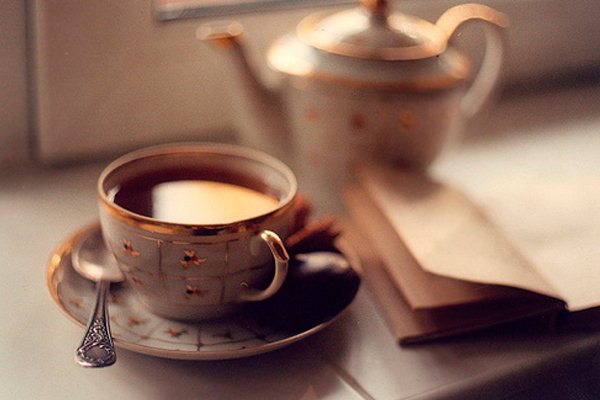当前位置: Language Tips> 英语学习专栏
中国茶道博大精深,英国茶文化也有其历史渊源和特别之处。中国茶叶种类繁多,茶道工序复杂,道道有禅机;而英国茶以其丰富的茶点著称,从维多利亚时期起的简单饮茶需求发展成如今重要的下午茶文化。一杯清茶,两个世界,我们既在文化中品茶,也在茶中品味文化。

By Aoife Inman
木沐 注
A brew, a cuppa or a “rosy lee”; the vernacular variation and inventiveness when it comes to naming the humble mug of tea in England is exhausting. We have developed our own colloquial language surrounding the culture of the common cuppa, mostly because of its intrinsic role in our daily lives.
Whilst in China I established a love of the wide variations of new tealeaves available at every corner. Moreover, the culture of preparation was new, the leaves were loose, brewed in a special filter pot and served in small dainty glasses. The delicacy and simplicity of Chinese tea was something I instantly became attached to and developed a yearning for upon arriving back in the U.K.
For most of us in England, “tea” is usually associated with teabags, but more specifically, bags of English breakfast tea. I realized, upon arrival in China, that this is not “real” tea. I struggle to remember a moment in my entire stay that I encountered tealeaves in an individual baggy.
Moreover, for most English tea drinkers, a brew is not complete without a dash of milk and a spoonful of sugar. Yet tea in China was a simple combination of leaves and boiled water, never sweetened or diluted with other ingredients. When I returned home even I had begun to find our obsession with milky, sweet tea a little insane. Chinese tea was, I decided, refreshingly simple and I returned home with a taste for beautiful fragrant green teas, jasmine flowers and chrysanthemum.
Yet despite the obvious differences, tea served a similar purpose in both cultures.
Mugs and cups of tea are a tradition in England amongst friends, for people of all generations. We will almost always reunite with friends and peers “over for a cuppa” and it is most definitely the drink of friendship, family and reunion, as well as being tightly engrained in everyday culture.
Yet whilst tea is primarily a casual, social convention, offered to you at every doorstep whether you are family, guest or the local builder, it can also, on occasion, become a formal event. The English tradition of “afternoon tea” appeared around the year 1840. The cultural history of the ritual of serving afternoon tea stems from a rather simple but interesting source.
Amongst the high classes of the 19th century, it was particularly fashionable to take your evening meal at around eight p.m. in the evening. However, this left a large gap of time between the second and third meals of the day. Afternoon tea, consisting of a small platter of cake, sandwiches and scones, and of course tea, was introduced by upper-class women who complained that they often got hungry at around four o’clock in the afternoon.
Although the tradition of afternoon tea has somewhat died out as an everyday occurrence, it has now become a luxury indulgence with many hotels, teahouses and restaurants offering the “afternoon tea” experience. In these you can partake in what seems an archaic piece of Victoriana culture.
Unlike in Shanghai where tea, chá, simply means the drink itself, afternoon tea in England is an entire social occasion with a mixture of patisserie, finger sandwiches (cut into long rectangular “fingers”) and cups of breakfast tea.
The “tea” is brought out to your table in a three-tier tray. Each layer is a delicate porcelain plate suspended in a wire frame. The contents of each section are different, organized in layers of sweet and savory offerings.
Arranged on the bottom plate is a variety of small finger sandwiches, bite-sized savory offerings of smoked salmon, cream cheese and cucumber. Above it lays a handful of scones, miniature jars of jam, butter and cream. Finally on the final layer are fresh cakes, éclairs, and Victoria sponges with delicate layers of piped cream and strawberry jam. There are also, of course, pots of earl grey and breakfast tea brought to the table, but they rather take a second seat next to the extravagant display of food.
The humble tealeaves seem to transcend 21st century cultural boundaries. During both my time in Shanghai and England tea was drunk and enjoyed as a simple, social activity between friends, a method of reconnection. However, beneath its role in everyday lives exists finesse and formality in the way tea is prepared, poured and enjoyed, emerging in beautifully preserved social traditions that capture our love of the simple cuppa.
Vocabulary
1. brew, cuppa或rosy lee,在英国,仅仅一杯茶就发明了好几种地方说法,这着实令人头疼。brew, cuppa, rosy lee: <英>茶,一杯茶;vernacular: 方言,本地话;inventiveness: 发明,创新;humble: 简单的,普通的;mug: 圆筒形带柄大杯,马克杯;exhausting: 使人精疲力竭的。
2. colloquial: 口语的,会话的;intrinsic: 内在的,固有的。
3. loose: 散装的;brew: (此处作动词)泡,沏;filter pot: 带滤网的茶壶;dainty: 精致的,考究的。
4. delicacy: 微妙,精美;(be) attached to: 喜爱;yearning: 渴望,向往。
5. 回想起待在中国的那段日子,我几乎记不得我曾经见到过茶包。
6. a dash of: 一点儿,少许;a spoonful of: 一匙。
7. dilute with: 用……冲淡;ingredient: 成分。
8. obsession: 迷恋;insane: 疯狂的,愚蠢的。
9. refreshingly: 令人精神振作地,使人耳目一新地;a taste for: 喜欢;fragrant: 芳香的;jasmine flower: 茉莉花;chrysanthemum: 菊花。
10. peer: 同事,同辈;engrained: 根深蒂固的。
11. convention: 传统,习俗。
12. ritual: 惯例,老规矩;stem from: 源于。
13. platter: 浅盘;scone: 烤饼,司康饼(一种源出英国的茶点)。
14. indulgence: 嗜好,爱好。
15. partake in: 参与;archaic: 古代的;Victoriana: 维多利亚时期的。该时期一般认为是1837—1901年,即维多利亚女王的统治时期,被认为是英国工业革命和大英帝国的巅峰时期。这个时期,英国盛行下午茶,并形成了多彩的茶文化。
16. patisserie: 法式糕点;finger sandwich: “手指”三明治,指长方形便于手抓的小块三明治;rectangular: 长方形的。
17. three-tier: 三层的;tray: 托盘。
18. 每层都有一个精致的瓷盘,用铁丝架固定住。porcelain: 瓷制的;suspend in: 悬于。
19. savory: 可口的。
20. smoked salmon: 烟熏三文鱼。
21. miniature: 小的;jar: 罐子,广口瓶。
22. the final layer: 这里指三层塔茶点的最上层;éclairs: <法>(手指形)巧克力泡芙;Victoria sponges: 维多利亚海绵蛋糕(一种果酱夹层蛋糕);piped cream: 奶油裱花。
23. earl grey: 伯爵茶(一种红茶);extravagant: 奢侈的,这里指极为丰盛的。
24. transcend: 超越。
25. 然而,在茶的日常角色之外,体现的是备茶、斟茶和用茶过程中的细致与正式,这成为保留完好并沿袭至今的社会传统,使简单的一杯茶俘获了我们的芳心。finesse: 精细;capture: 捕捉,俘获。
(来源:英语学习杂志 编辑:董静)
上一篇 : 一个美国人到英国留学的故事
下一篇 :
关注和订阅

电话:8610-84883645
传真:8610-84883500
Email: languagetips@chinadaily.com.cn